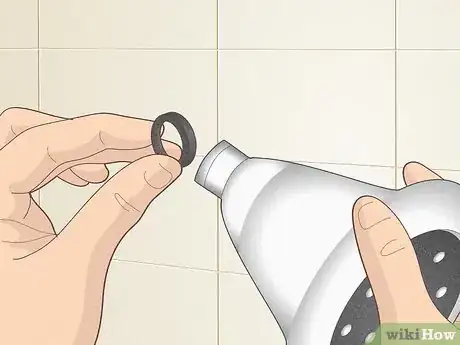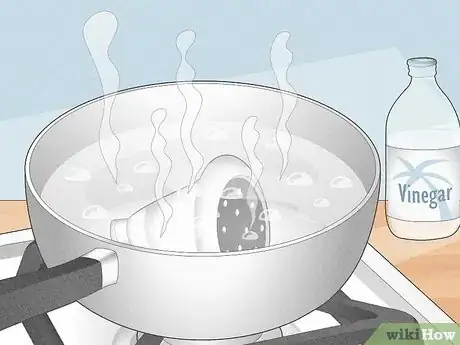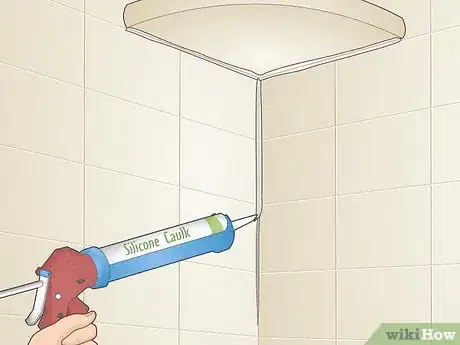This article was co-authored by Patrick Johns. Patrick Johns is a Home Improvement Specialist and the Owner of CatchAll Handyman Services. With more than 28 years of experience, he has worked on a variety of home improvement projects, such as carpentry, plumbing, and door and window installations in both commercial and residential properties.
This article has been viewed 22,834 times.
A leaking shower is a problem you don't want to ignore, because water damage can wreak havoc on your home. Luckily, many common causes of shower leaks can be easily fixed. If your showerhead is leaking, you can clean it and reseal it. A leaking shower faucet will take a little more work to repair, but the problem can usually be fixed by replacing the faucet cartridge. Leaks around the faucet plate or shower seals can usually be taken care of with a quick application of caulk or plumber's putty.
Steps
Repairing the Showerhead
-
1Turn off the water main. Shut off the water to your entire house to keep from making a huge mess. Get a towel or two to help sop up any water left in the pipes.[1]
- The main water controls should be in your basement or outside the house.
- If you can find a dedicated shut off valve for the shower (usually behind a panel on the other side of the wall), you can turn the water off there instead. However, this is not easily accessible in all homes.
-
2Unscrew the showerhead. Grasp the showerhead by hand and turn it to the left (counterclockwise) until it comes off. If it's stuck, grab it with an adjustable wrench and try turning it again.[2]
- Wrap the wrench teeth with duct tape to prevent damaging the finish on the shower head.
Advertisement -
3Check the condition of the showerhead. Look at the plastic washer or rubber O-ring inside the threads. If this is worn or broken, it can cause a showerhead to leak.[3]
- If the washer or O-ring is worn out, go to the hardware store and buy a new one.
-
4Clean the showerhead. Mix 3 cups of water and 3 cups of vinegar (about 700 mL of each) in a pot and let it boil. Cut off the heat, and place the showerhead in the pot. Keep it there for 20-30 minutes, then scrub and rinse it. This will remove mineral build-up that can slow down or block the faucet.[4]
-
5Tape the pipe threads before reattaching the showerhead. Wrap a thin layer of Teflon tape around the threads at the end of the pipe that holds the showerhead. Then screw the showerhead back on. This tape ensures a good seal.[5]
-
6Unscrew and tape the showerhead arm if the leak is from the wall. If you notice water dripping at the point where the metal pipe the showerhead is attached to meets the wall, the pipe threads may not be sealed correctly. Grasp the whole pipe, including the showerhead, and turn it counterclockwise until it comes out from the wall.[6]
- Wrap a thin layer of teflon tape around the exposed threads at the end of the pipe.
- Turn the pipe clockwise to screw it back into the wall.
Repairing a Leaking Shower Faucet
-
1Check that you have a cartridge-style faucet. The most common type of shower faucet has a single handle that turns left or right to make water hot and cold. This type is controlled by an internal cartridge that is easily replaced if it's faulty.
- Other faucets have two handles (one each for hot and cold water), or work as a lever rather than turning left and right. These use either ball valves or ceramic disks and are more complicated to repair. Contact a plumber for assistance.
-
2Take off the cap on the handle. Make sure to turn off the water to your shower first. Then, take a small flathead screwdriver or pocket knife to pry off the cap at the tip of the faucet handle. You'll see a screw underneath it.[7]
- Cover the shower drain with a rag to keep screws from accidentally slipping down it.
-
3Loosen the screw inside the handle. Grab a phillips-head screwdriver and set it on the screw at the center of the faucet handle. Turn it to the left (counterclockwise) to loosen it. Keep turning until you are able to pull the handle off.[8]
- The cartridge may have a hex screw instead. If so, use a hex wrench to loosen it.
- The handle may stick a little bit. If so, try blowing on it with a hairdryer for a few minutes, then try again to pull it off.
- If that still doesn't work, go to your local hardware store and ask for a device called a “handle puller” which will give you additional leverage to pull the handle off.
-
4Pop off the retaining clip. If you look at where the faucet was, you'll see the tip of the cylindrical cartridge. You'll also see a small metal clip that holds the cartridge in place. Slide a small flathead screwdriver under the edge of the clip, and pry upwards until it pops off.[9]
-
5Twist out the cartridge. Remove the small round washer around the tip of the cylinder, just by pulling it off. Then, twist the cartridge counterclockwise to loosen it, and pull until it comes out. Use pliers to grab the cartridge cylinder and twist/pull if necessary.[10]
- If the cartridge is stuck and won't come out, Use the cartridge puller. This slides over the end of the cartridge and gives you additional leverage to twist it out.
-
6Purchase a new cartridge cylinder. Take the cartridge with you to the hardware or plumbing supply store. Make sure you buy the same type. Ask an assistant to help you if you can't find the right one.[11]
-
7Replace the cartridge. Insert your new cartridge exactly where the old one went. Slide the retaining clip back in to hold the new cartridge in place. Slide the washer and faucet handle back on. Screw the faucet in place by turning the screw clockwise, pop the cap on the end of the faucet, and you're done.[12]
Sealing the Faucet Plate
-
1Remove the faucet plate. Also known as the escutcheon, the plate behind the faucet handle is a common site for leaks. Unscrew the faucet handle with a philips head screwdriver just as you would to replace the cartridge. Then, use a screwdriver to remove the couple of screws holding the plate in place against the wall.[13]
- Pull the escutcheon off of the wall when you're done. Gently pry at it with a flathead screwdriver if it seems stuck.
-
2Check the escutcheon gasket. You should see a rubber or foam seal going around the inside of the escutcheon. If it is missing or worn out, or doesn't go all the way around the escutcheon, it's time to replace the seal.[14]
-
3Create a ring of plumber's putty to form a new gasket. Grab a fist-sized wad of plumber's putty and knead it in your hands until it is soft and pliable. Roll it into a line about 0.5 inches (1.3 cm) thick. Wrap this line around the inside of the escutcheon.[15]
-
4Replace the escutcheon and faucet handle. Set the escutcheon back on the wall and screw it back into place. Then reattach the faucet handle. Some of the plumber's putty will probably squeeze out of the sides of the escutcheon. If so, just wipe it away with a damp cloth.[16]
Fixing the Shower Seals
-
1Check the shower seal for holes. Look around the edges on every side of the shower. If you see any holes between the shower lining and wall, or between the shower door and wall (if applicable), you'll need to seal these up to prevent leaks.[17]
-
2Clean any damaged areas. If any existing caulk or sealing material is damaged or loose, remove it. If it doesn't come away easily, use a sharp knife to cut it off. Clean the areas with a bathroom cleaner to remove dirt and debris before repairing the damage.
-
3Caulk any holes you see with silicone caulk. Find silicone caulk at any hardware store. Squeeze some out of the tube onto any holes you notice in the seals around the shower edges or shower door.[18]
- Silicone caulk is waterproof and widely available. It's the best option for sealing showers. Look for a variety specially marked for kitchens or baths, if possible.
-
4Remove the excess caulk. Working from the bottom to the top, scrape over the caulking with a popsicle stick or similarly shaped object. Go slowly, and wipe the excess off onto a rag. When you're done, spray the caulked area down with any mild household cleaner, then wipe it with a cloth rag to make the area look nice.[19]
- Scrapping over the caulk with a popsicle stick and wiping it with a wet rag just helps make a smooth, even surface.
- For a simpler fix, you can go over the caulk with a wet finger instead.
Things You'll Need
Repairing the Showerhead
- Towels
- Adjustable wrench
- Replacement O-ring (optional)
- Vinegar
- Teflon tape
Repairing a Leaking Shower Faucet
- Flathead screwdriver
- Philips head screwdriver
- Hex wrench (optional)
- Hairdryer (optional)
- Handle puller (optional)
- Cartridge puller (optional)
- New faucet cartridge
Sealing the Faucet Plate
- Philips head screwdriver
- Plumber's putty
- Cloth rag
Sealing the Shower Walls
- Silicone caulk
- Popsicle stick
- Mild household cleaner
- Cloth rag
References
- ↑ https://projects.truevalue.com/maintenance_and_repair/bathroom/repair_a_dripping_showerhead.aspx
- ↑ https://projects.truevalue.com/maintenance_and_repair/bathroom/repair_a_dripping_showerhead.aspx
- ↑ https://projects.truevalue.com/maintenance_and_repair/bathroom/repair_a_dripping_showerhead.aspx
- ↑ https://projects.truevalue.com/maintenance_and_repair/bathroom/repair_a_dripping_showerhead.aspx
- ↑ https://projects.truevalue.com/maintenance_and_repair/bathroom/repair_a_dripping_showerhead.aspx
- ↑ https://www.thisoldhouse.com/how-to/how-to-troubleshoot-leaky-shower
- ↑ https://www.familyhandyman.com/plumbing/faucet-repair/how-to-fix-a-dripping-shower/view-all/
- ↑ https://www.familyhandyman.com/plumbing/faucet-repair/how-to-fix-a-dripping-shower/view-all/
- ↑ https://www.familyhandyman.com/plumbing/faucet-repair/how-to-fix-a-dripping-shower/view-all/
- ↑ https://www.familyhandyman.com/plumbing/faucet-repair/how-to-fix-a-dripping-shower/view-all/
- ↑ https://www.familyhandyman.com/plumbing/faucet-repair/how-to-fix-a-dripping-shower/view-all/
- ↑ https://www.homeadvisor.com/r/shower-faucet-repair-guide/
- ↑ https://www.thisoldhouse.com/how-to/how-to-troubleshoot-leaky-shower
- ↑ https://www.thisoldhouse.com/how-to/how-to-troubleshoot-leaky-shower
- ↑ https://www.thisoldhouse.com/how-to/how-to-troubleshoot-leaky-shower
- ↑ https://www.thisoldhouse.com/how-to/how-to-troubleshoot-leaky-shower
- ↑ https://www.thisoldhouse.com/how-to/how-to-troubleshoot-leaky-shower
- ↑ https://www.thisoldhouse.com/how-to/how-to-troubleshoot-leaky-shower
- ↑ https://www.bunnings.co.nz/diy-advice/bathroom/baths-showers-and-toilets/how-to-fix-a-leaking-shower.
About This Article
To fix a leaking shower head, shut off the water and twist the shower head counterclockwise to take it off. Examine the piece for worn or broken washers and rubber O-rings and replace the pieces, as needed. Next, mix 3 cups of water and 3 cups of vinegar in a pot, bring the mixture to a boil, and remove it from the heat. Then, soak the shower head in the solution for 20-30 minutes to remove mineral buildup. Finally, reattach the shower head and test it out! For tips on fixing a leaky shower faucet, read on!














































































